Amazon Selling Partner (SP-API) Connector for SSRS
Amazon Selling Partner Connector (SP-API) can be used to integrated SP-API that helps Amazon sellers to programmatically exchange data on listings, orders, payments, reports, and more.
In this article you will learn how to quickly and efficiently integrate Amazon Selling Partner (SP-API) data in SSRS without coding. We will use high-performance Amazon Selling Partner (SP-API) Connector to easily connect to Amazon Selling Partner (SP-API) and then access the data inside SSRS.
Let's follow the steps below to see how we can accomplish that!
Amazon Selling Partner (SP-API) Connector for SSRS is based on ZappySys API Driver which is part of ODBC PowerPack. It is a collection of high-performance ODBC drivers that enable you to integrate data in SQL Server, SSIS, a programming language, or any other ODBC-compatible application. ODBC PowerPack supports various file formats, sources and destinations, including REST/SOAP API, SFTP/FTP, storage services, and plain files, to mention a few.
Video Tutorial - Integrate Amazon Selling Partner (SP-API) data in SSRS
This video covers the following topics and more, so please watch carefully. After watching the video, follow the steps outlined in this article:
- How to download and install the required PowerPack for
Amazon Selling Partner (SP-API) integration in SSRS - How to configure the connection for
Amazon Selling Partner (SP-API) - Features of the
ZappySys API Driver (Authentication / Query Language / Examples / Driver UI) - How to use the
Amazon Selling Partner (SP-API) in SSRS
Create Data Source in ZappySys Data Gateway based on API Driver
-
Download and install ODBC PowerPack.
-
Search for gateway in start menu and Open ZappySys Data Gateway:

-
Go to Users Tab to add our first Gateway user. Click Add; we will give it a name tdsuser and enter password you like to give. Check Admin option and click OK to save. We will use these details later when we create linked server:

-
Now we are ready to add a data source. Click Add, give data source a name (Copy this name somewhere, we will need it later) and then select Native - ZappySys API Driver. Finally, click OK. And it will create the Data Set for it and open the ZS driver UI.
AmazonSellingPartnerSpApiDSN

-
When the Configuration window appears give your data source a name if you haven't done that already, then select "Amazon Selling Partner (SP-API)" from the list of Popular Connectors. If "Amazon Selling Partner (SP-API)" is not present in the list, then click "Search Online" and download it. Then set the path to the location where you downloaded it. Finally, click Continue >> to proceed with configuring the DSN:
AmazonSellingPartnerSpApiDSNAmazon Selling Partner (SP-API)
-
Now it's time to configure the Connection Manager. Select Authentication Type, e.g. Token Authentication. Then select API Base URL (in most cases, the default one is the right one). More info is available in the Authentication section.
Amazon Selling Partner (SP-API) authentication
Amazon Sellers can use SP-API to set up private integrations and build solutions exclusively for their Amazon store. Private app is available only to your organization and is self-authorized. A private developer builds application(s) that integrate their own company with Amazon APIs. [API reference]
Perform the following steps to authenticate calls using Amazon SP-API Private app:
- Register as an Amazon Private SP-API Developer. You may need to wait for a day or two to get approved (check approval status).
-
Once your developer account is approved,
login to your account, visit developer console
and click Add new app client button to create a Private app:
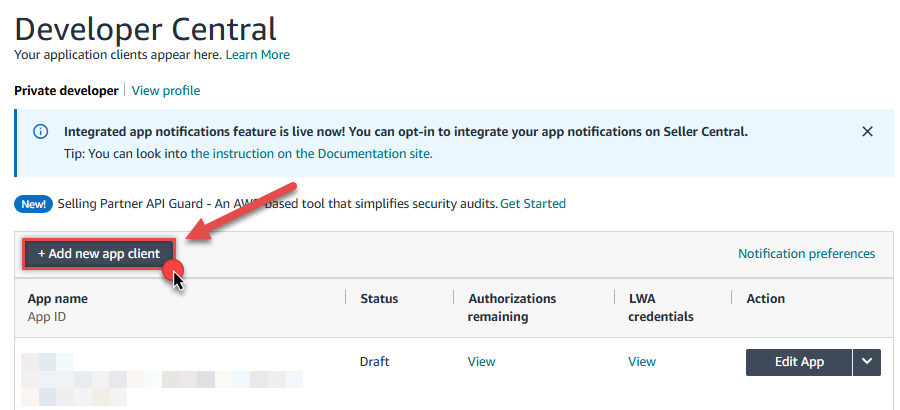
-
Continue by naming your application in the App name field,
choose
SP APIas API Type, and select the Roles for your app (i.e. permissions):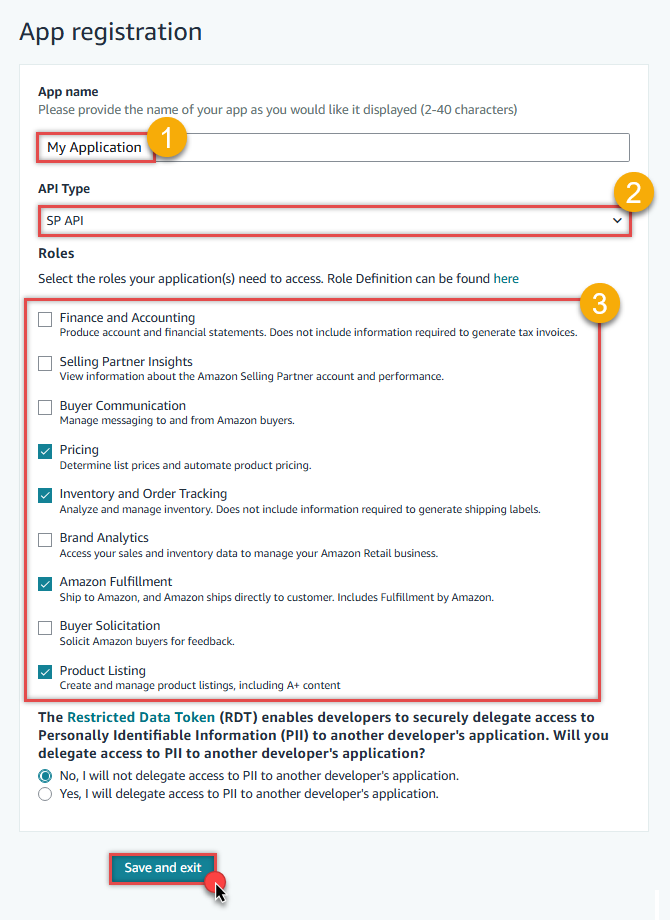
-
Once you do that, click View link in LWA credentials column to
copy Client identifier and Client secret (we will use them later):

-
Now it's time to Authorize your app:
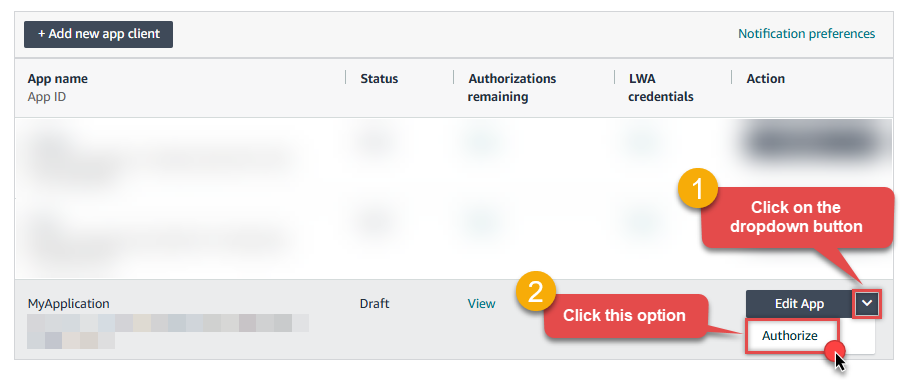
-
Finish authorizing it by presing Authorize app button:
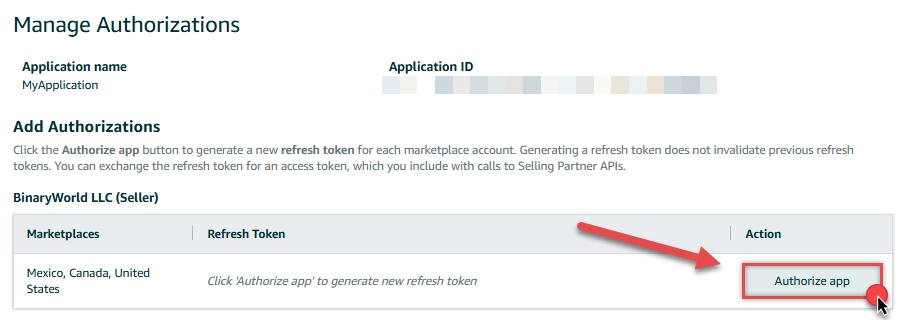
-
Finally, copy the Refresh Token (we will use it in the next step):

-
Now go to SSIS package or ODBC data source and use Private app authentication configuration:
- In the ClientId field paste the Client identifier value you copied in the previous step.
- In the ClientSecret field paste the Client secret value you copied in the previous step.
- Leave the default value in the TokenUrl field.
- In the Refresh Token field paste the Refresh Token value you copied in the previous step.
- Click Test Connection to confirm the connection is working.
- Done! Now you are ready to use Amazon Selling Partner (SP-API) Connector!
API Connection Manager configuration
Just perform these simple steps to finish authentication configuration:
-
Set Authentication Type to
Private app [OAuth] - Optional step. Modify API Base URL if needed (in most cases default will work).
- Fill in all the required parameters and set optional parameters if needed.
- Press Generate Token button to generate the tokens.
- Finally, hit OK button:
AmazonSellingPartnerSpApiDSNAmazon Selling Partner (SP-API)Private app [OAuth]https://sellingpartnerapi-na.amazon.comRequired Parameters ClientId Fill-in the parameter... ClientSecret Fill-in the parameter... TokenUrl Fill-in the parameter... Optional Parameters TokenUIMode OnlyRefreshToken AuthUrl (Do not Use for Private app - Self Authorization) https://sellercentral.amazon.com/apps/authorize/consent?application_id=[YOUR-APPLICATION-ID]&version=beta OrdersApiVersion v0 SellerApiVersion v1 ShippingApiVersion v1 ServicesApiVersion v1 FbaApiVersion v1 SalesApiVersion v1 ReportsApiVersion 2021-06-30 ProductsFeesApiVersion v0 ProductPricingApiVersion v0 CatalogItemsApiVersion 2022-04-01 VendorOrdersApiVersion v1 RetryMode RetryWhenStatusCodeMatch RetryStatusCodeList 429 RetryCountMax 5 RetryMultiplyWaitTime True 
-
Once the data source connection has been configured, it's time to configure the SQL query. Select the Preview tab and then click Query Builder button to configure the SQL query:
 ZappySys API Driver - Amazon Selling Partner (SP-API)Amazon Selling Partner Connector (SP-API) can be used to integrated SP-API that helps Amazon sellers to programmatically exchange data on listings, orders, payments, reports, and more.AmazonSellingPartnerSpApiDSN
ZappySys API Driver - Amazon Selling Partner (SP-API)Amazon Selling Partner Connector (SP-API) can be used to integrated SP-API that helps Amazon sellers to programmatically exchange data on listings, orders, payments, reports, and more.AmazonSellingPartnerSpApiDSN
-
Start by selecting the Table or Endpoint you are interested in and then configure the parameters. This will generate a query that we will use in SSRS to retrieve data from Amazon Selling Partner (SP-API). Hit OK button to use this query in the next step.
SELECT * FROM Orders --WHERE AmazonOrderId='902-1845936-5435065' WITH( CreatedAfter='1900-01-01T00:00:00' -- , CreatedBefore='1900-01-01T00:00:00' -- , LastUpdatedAfter='1900-01-01T00:00:00' -- , LastUpdatedBefore='1900-01-01T00:00:00' -- , OrderStatuses='Pending~Unshipped~PartiallyShipped~PendingAvailability~Shipped~Canceled~Unfulfillable' -- , MarketplaceIds='ATVPDKIKX0DER~A2Q3Y263D00KWC~A2EUQ1WTGCTBG2' -- , FulfillmentChannels='AFN~MFN' -- , PaymentMethods='COD~CVS~Other' -- , AmazonOrderIds='1111111,222222,333333' ) --CONNECTION( -- ServiceUrl='https://sellingpartnerapi-na.amazon.com' --) Some parameters configured in this window will be passed to the Amazon Selling Partner (SP-API) API, e.g. filtering parameters. It means that filtering will be done on the server side (instead of the client side), enabling you to get only the meaningful data
Some parameters configured in this window will be passed to the Amazon Selling Partner (SP-API) API, e.g. filtering parameters. It means that filtering will be done on the server side (instead of the client side), enabling you to get only the meaningful datamuch faster . -
Now hit Preview Data button to preview the data using the generated SQL query. If you are satisfied with the result, use this query in SSRS:
 ZappySys API Driver - Amazon Selling Partner (SP-API)Amazon Selling Partner Connector (SP-API) can be used to integrated SP-API that helps Amazon sellers to programmatically exchange data on listings, orders, payments, reports, and more.AmazonSellingPartnerSpApiDSN
ZappySys API Driver - Amazon Selling Partner (SP-API)Amazon Selling Partner Connector (SP-API) can be used to integrated SP-API that helps Amazon sellers to programmatically exchange data on listings, orders, payments, reports, and more.AmazonSellingPartnerSpApiDSNSELECT * FROM Orders --WHERE AmazonOrderId='902-1845936-5435065' WITH( CreatedAfter='1900-01-01T00:00:00' -- , CreatedBefore='1900-01-01T00:00:00' -- , LastUpdatedAfter='1900-01-01T00:00:00' -- , LastUpdatedBefore='1900-01-01T00:00:00' -- , OrderStatuses='Pending~Unshipped~PartiallyShipped~PendingAvailability~Shipped~Canceled~Unfulfillable' -- , MarketplaceIds='ATVPDKIKX0DER~A2Q3Y263D00KWC~A2EUQ1WTGCTBG2' -- , FulfillmentChannels='AFN~MFN' -- , PaymentMethods='COD~CVS~Other' -- , AmazonOrderIds='1111111,222222,333333' ) --CONNECTION( -- ServiceUrl='https://sellingpartnerapi-na.amazon.com' --) You can also access data quickly from the tables dropdown by selecting <Select table>.A
You can also access data quickly from the tables dropdown by selecting <Select table>.AWHEREclause,LIMITkeyword will be performed on the client side, meaning that thewhole result set will be retrieved from the Amazon Selling Partner (SP-API) API first, and only then the filtering will be applied to the data. If possible, it is recommended to use parameters in Query Builder to filter the data on the server side (in Amazon Selling Partner (SP-API) servers). -
Click OK to finish creating the data source.
-
Most Important Step: Now, After creating or modifying a data source in ZappySys Data Gateway, make sure to click the SAVE button to preserve your changes.
Then, RESTART the Data Gateway service to ensure all changes are properly applied.Skipping either step may result in the new settings not taking effect.

Read data in SSRS from ZappySys Data Gateway
- Open Visual Studio and create a new SSRS project
-
Then add a new Shared Data Source (you can create a non-shared data source inside report too):
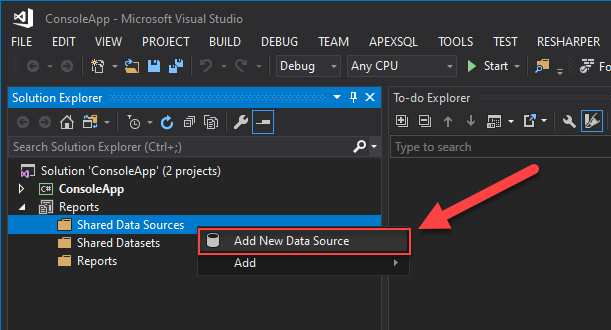
-
Continue with creating the Shared Data Source. Select Microsoft SQL Server as Type and hit Build button to proceed further:
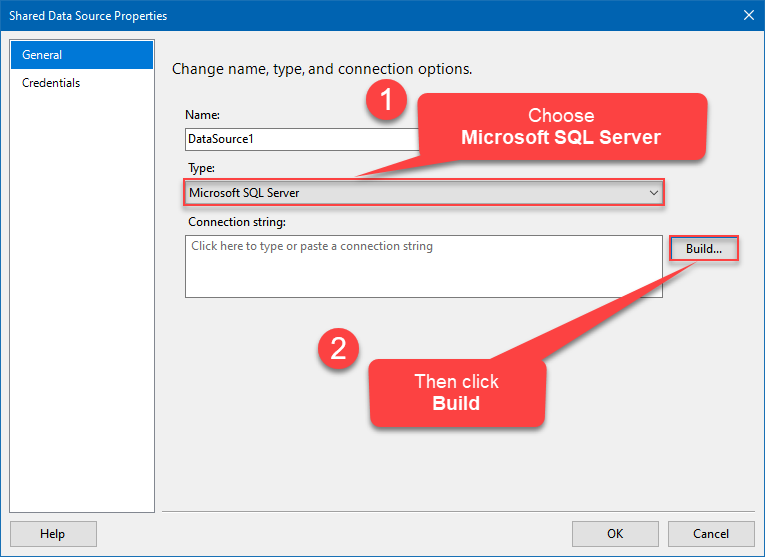
-
Once a window opens, configure it similarly. Configure "AmazonSellingPartnerSpApiDSN" as database name. Finally, hit Test Connection and OK:
AmazonSellingPartnerSpApiDSN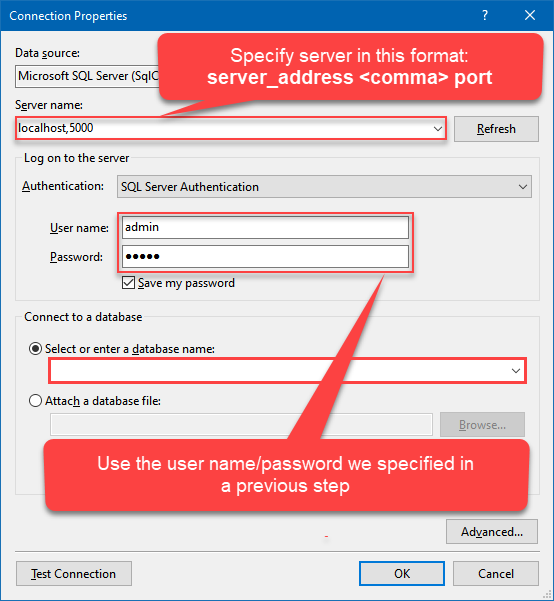
-
Another window opens, and it should look similarly to this one below which ends the creation of a Data Source:
DataSource=localhost,5000;Initial Catalog=AmazonSellingPartnerSpApiDSN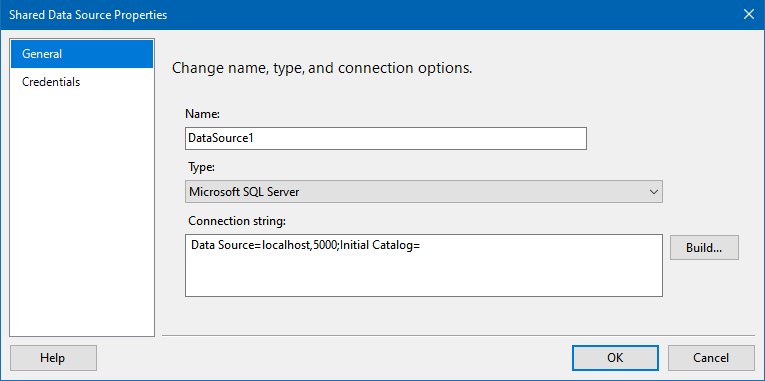
-
Now it's time to create a Dataset. If you don't have a report created, in one of the wizard's steps it will look like this:
SELECT * FROM Orders --WHERE AmazonOrderId='902-1845936-5435065' WITH( CreatedAfter='1900-01-01T00:00:00' -- , CreatedBefore='1900-01-01T00:00:00' -- , LastUpdatedAfter='1900-01-01T00:00:00' -- , LastUpdatedBefore='1900-01-01T00:00:00' -- , OrderStatuses='Pending~Unshipped~PartiallyShipped~PendingAvailability~Shipped~Canceled~Unfulfillable' -- , MarketplaceIds='ATVPDKIKX0DER~A2Q3Y263D00KWC~A2EUQ1WTGCTBG2' -- , FulfillmentChannels='AFN~MFN' -- , PaymentMethods='COD~CVS~Other' -- , AmazonOrderIds='1111111,222222,333333' ) --CONNECTION( -- ServiceUrl='https://sellingpartnerapi-na.amazon.com' --)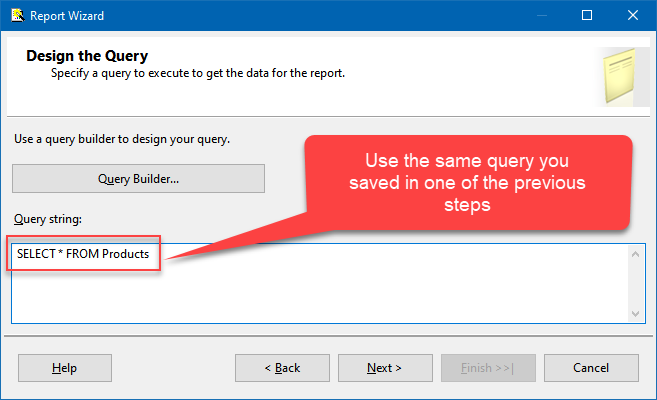
-
Finally, once you complete the report, similar results will show up:
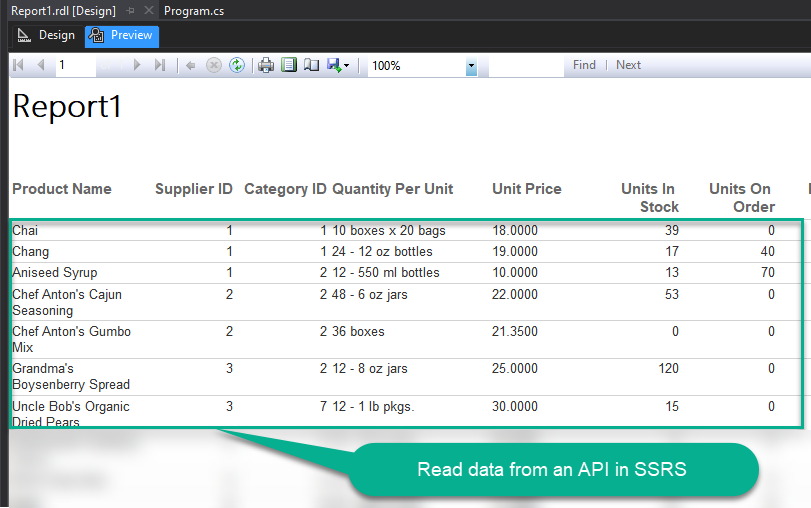
Passing Parameters to SSRS Report / Filter data
If you want to parameterize your report, then refer to this article
Actions supported by Amazon Selling Partner (SP-API) Connector
Learn how to perform common Amazon Selling Partner (SP-API) actions directly in SSRS with these how-to guides:
- Download Report File to Local Disk
- Get FBA Inventory Summaries (Fulfilled By Amazon)
- Get Market Place Participations
- Get Order (Single)
- Get Order Items (For Single Order)
- Get Orders
- Get Orders Items (For All Orders **Slow**)
- Get Report Data - Comma Separated File (CSV)
- Get Report Data - JSON File
- Get Report Data - Tab Separated File (TSV)
- Get Report Data - XML File
- Get Report Filters
- Get Report Options
- Get Report Types
- Get Vendor PurchaseOrder Items
- Get Vendor PurchaseOrders
- Search Catalog Items
- Make Generic API Request
- Make Generic API Request (Bulk Write)
Conclusion
In this article we showed you how to connect to Amazon Selling Partner (SP-API) in SSRS and integrate data without any coding, saving you time and effort.
We encourage you to download Amazon Selling Partner (SP-API) Connector for SSRS and see how easy it is to use it for yourself or your team.
If you have any questions, feel free to contact ZappySys support team. You can also open a live chat immediately by clicking on the chat icon below.
Download Amazon Selling Partner (SP-API) Connector for SSRS Documentation











































































